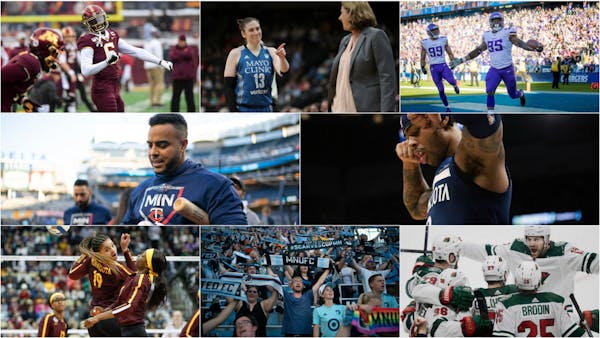With reports swirling last weekend that the Big Ten and Pac-12 were readying to cancel the football season, players from the Power Five conferences joined together to issue a list of demands.
One of those has the potential to change college football forever.
"Use our voices to establish open communication and trust between players and officials: ultimately create a college football players association," the statement read.
While the Big Ten and Pac-12 fall football seasons were indeed canceled, and the SEC, Big 12 and ACC continue to grapple with a way to safely play amid the coronavirus pandemic, players' renewed call for representation feels more real than ever — and could emerge as the single most defining development from these past several months.
"I don't want to specifically say unionization, but the way it's headed is, we want to make sure that all the athletes are more organized and on the same page," Gophers senior Seth Green said, "and all voices are heard from different perspectives."
While unions have more power because of a legal obligation for employers to negotiate with them, college football players have failed in the past to form a union, a notable example being Northwestern in 2015. Those players, who organized to collectively bargain for rights such as sponsorship compensation for players, couldn't gain recognition as employees from the National Labor Relations Board, which oversees private institutions like Northwestern.
Creating a Power Five union would likely involve state governments, because most schools are public. But many southern states have laws that make unionizing hard, said Gabe Feldman, director of the Tulane Sports Law Program.
Feldman said with the current political climate, he doubts efforts to unionize now would be any more successful than in the past. Societally, though, the pandemic might have magnified some feelings of exploitation that have simmered under the surface for years.
A powerful moment
College football players have always been the labor behind incredible revenues — the Gophers, for example, stand to lose $75 million without a season this fall — but don't earn compensation beyond the cost of attending school and are only now gaining headway on eventually profiting off their names, images and likenesses.
In Division I football, players are also nearly 50% Black, while their coaches and athletic directors are about 80% white, bringing in a civil rights dynamic that came to the forefront this summer after the death of a Black man, George Floyd, in Minneapolis police custody. The long-term effect of football injuries, including concussions, has been a major concern in recent years but became an urgent matter with COVID-19 posing unknown risks.
"Those are three major areas that are coming together now … that have never come together before," Feldman said. "And it doesn't mean that we will get a college players association. It doesn't mean we'll get a union. It doesn't mean we'll get significant change. But this is as powerful a moment as any for college athletes to try."
That's already started at the most basic level: social media. A group of Pac-12 players shared an open letter early this month demanding better safety practices, racial equality and economic equity, or else they would opt out of the season. A group of Big Ten players, including Green and Gophers teammate Benjamin St-Juste, formed College Athlete Unity, and followed with a list of health and safety requests. Then players such as Clemson Heisman front-runner quarterback Trevor Lawrence tweeted that Sunday statement.
"We'll see how it continues to move forward," Gophers coach P.J. Fleck said Friday of players potentially unionizing. "I think, as we've seen in the last five, six months, the players' voice has come forward in a lot of situations."
That chorus could potentially combine into a trade organization. The NCAA wouldn't necessarily have to include that in decision-making, but the players do hold enormous leverage, should they all threaten to not play or build support with prominent stars like Lawrence championing the cause. That organization could also gain the backing of politicians, who can also lean on the NCAA.
"I don't think it's enough to just have a manifesto on a website that hopes for change," Feldman said. " … There would need to be some lever that the players could pull that would put pressure on the NCAA to make change because, as we know, the NCAA is slow to make change."
Steps could have future reach
Green said he hopes a more formal group evolves soon, though the pandemic has made that a slower process. It will also bring unique challenges, such as deciding whether the group will represent just Power Five football players or all college football players. And the larger the group becomes, the harder it will be to come to a consensus on what to push for, which would make the NCAA less likely to listen.
Plus, the membership will turn over about every four years, meaning players like Green who are fighting to establish the group now in their final year of eligibility won't actually experience any of the benefits.
But that doesn't matter to Green, as long as future football players are finally allowed in the room where it happens.
"Making sure … the student-athletes have a seat at the table, in conversations with the conferences and the NCAA when big decisions are being made that are, in fact, going to affect the student-athletes themselves," Green said. "It just makes more sense to have somebody there and a part of the conversation who actually, you know, has to live with the actions that are being set in place."






